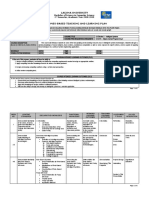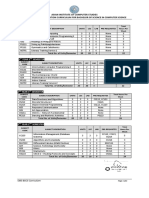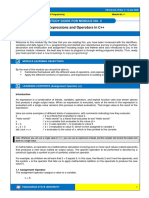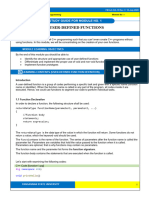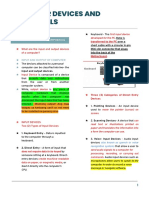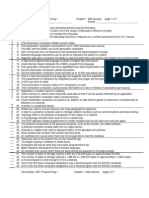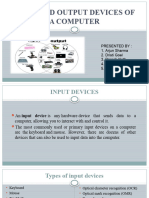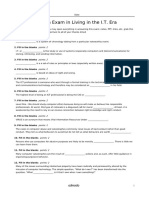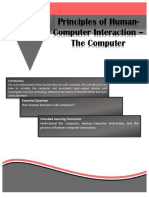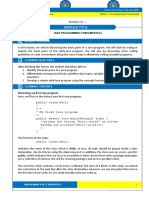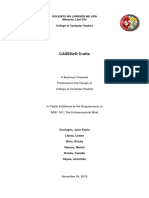PALAWAN STATE UNIVERSITY
College of Sciences
GE ELECT 1
LIVING IN THE IT ERA
Module 9
HEALTH
CONCERNS ON
COMPUTER
USE 1
� Learning Outcomes
After going through in this module, you should be able to:
✔ Describe Ergonomics.
✔ Describe the various health issues when utilizing IT
resources.
✔ Advocate ways to prevent health-related disorders and
injuries due to computer use.
✔ Promote ways to reduce electricity and environmental
waste while using computer resources.
2
� Overview
Since you have been well acquainted with the essence of digital security
and the implications of cybercrime, the next topic focuses towards health
issues on using computers. As the security status of your digital
information is important, so is the health status of your physical body and
the ways you can contribute to lessen electronic wastes.
In this module, you will learn the concept of Ergonomics and Green
Computing and the rise of health issues and environmental issues due
improper practice involving computers.
3
� Initial Activity
Before going through this module, let us first check your prior knowledge
about this topic.
Try to fill out the hexagons with words that comes to your mind when you
hear the word “Health Concerns”.
4
� Discussion
ERGONOMICS
Ergonomics (or human factors) is the scientific discipline concerned with
the understanding of interactions among humans and other elements of a
system, and the profession that applies theory, principles, data and
methods to design to optimize human well-being and overall system
performance.
The goals of Ergonomics are to:
● Reduce human error;
● Increase productivity; and
● Enhance safety and comfort.
All of these goals are set with a specific focus on the interaction between
the human and the thing of interest.
The terms “ergonomics” and “human factors” are essentially synonymous.
For the rest of the discussion, we will use the term “ergonomics” and
focus on the “use of IT Resources” as its thing of interest.
5
� Discussion
ERGONOMICS
Ergonomics is concerned with the “fit” between the user, equipment, and
environment or “fitting a job to a person”.
Ergonomics comprise three main fields of research:
1) Physical;
2) Cognitive; and
3) Organizational Ergonomics.
Although the last two fields are important, this module will only focus on
the first field: Physical Ergonomics.
Physical Ergonomics is concerned with human anatomy, and some of the
anthropometric, physiological and bio-mechanical characteristics as they
relate to physical activity. It is the science of designing user interaction
with equipment and workplaces to fit the user.
6
� Discussion
ERGONOMICS
The usual IT resources that people use are desktop computers and
laptops. Think of the academe setting, students and teachers alike work
with computers in doing school-related documents and requirements.
Majority of schoolworks would require long hours in producing reports and
projects that are done with computer applications.
Office workers complain commonly of a number of health problems, such
as musculoskeletal disorders, which include upper limb disorders (ULDs)
and backache, as well as eye fatigue, headaches, and stress.
The following musculoskeletal disorders are some of the most common
disorders in the workplace.
7
� Discussion
ERGONOMICS
Upper limb disorders (ULDs), also called cumulative trauma disorders,
is an umbrella term that indicates an injury has occurred anywhere from
the fingertips, along the arm, and into the shoulder, and, possibly, the
back of the neck.
The following are the types of Upper limb disorders associated with
computer use:
1. Carpal Tunnel Syndrome. This results from compression of the
median nerve. Forceful gripping, irregular wrist postures, and
vibration are associated with its development. Typical symptoms
include numbness and tingling in the hand and night waking.
1. Epicondylitis. This results from overuse of the muscles that bend
the hand up or down at the wrist. Forearm rotation and forceful
movements of the wrist and forearm are also likely contributors.
8
� Discussion
ERGONOMICS
3. Frozen Shoulder. This can result from repeated sustained
overhead work and results in a gradual onset of pain, which is more
prominent at night, and restriction of movement.
3. Osteoarthritis. This causes stiffness, aching, and restriction of
movement. It occurs most often in joints that are subject to long-term
stress.
The main causes of ULDs are repetition, awkward posture, static muscle
work, force, and duration of activity.
9
� Discussion
ERGONOMICS
Backache can be related to the adoption and maintenance of poor
working postures, poor workstation design, lack of training, and manual
handling.
Backache can be avoided by using suitable workstation furniture, using it
correctly, and leaving the workstation at regular intervals. Appropriate
manual handling training should also be provided where required.
Visual fatigue results from the effort of trying to see. Symptoms of visual
fatigue include redness of the eyes, itching in the eyes, double vision,
blurred vision, aching eyes, watering eyes, headaches, and nausea.
The main causes of visual fatigue are poor screen position relative to
overhead lights and windows, glare, inappropriate viewing distances,
badly designed screen displays, unsuitable environmental conditions, and
extended screen work.
10
� Discussion
ERGONOMICS
Stress results from mismatches between the demands placed on
individuals and their ability to meet those demands. Prolonged stress can
lead to anxiety, depression, heart disease, back pain, and gastrointestinal
problems.
Stress is closely associated with role ambiguity, role conflict, excessive
demands, a gap between demands and capabilities, lack of autonomy,
isolation from the process of change, and social interaction within the
workplace.
11
� Learning Check
Based on the various health concerns when utilizing IT resources, which
among those health concerns have you experienced?
HEALTH CONCERN POSSIBLE CAUSE
1.
2.
3.
12
� Discussion
PROTECT YOURSELF FROM STRAIN AND PAIN
You may notice when you are using your computer on your desk while
sitting in long hours that some parts of your body are sore. This is
probably caused by your wrong posture while sitting. Ergonomics finds a
way in order to provide comfort and effective ways when using computers
for a period of time.
The following discussion will help you in working on your posture and the
materials (or accessories) that would aid help you to do so.
I. Sitting vs Standing
If the task lends itself to an individual sitting down, a suitable chair should
be provided to allow them to do so. Sitting offers advantages over
standing in that people can take the weight off their legs, have greater
stability for the upper body, and reduce energy expenditure and demands
on the circulatory system. Standing desks provide opportunities for the
person to change their posture. Prolonged standing can result in
physiological changes, including
an increase in heart rate. There is general agreement that people are not
designed to sit for extended periods without interruption. Many individuals
work in a manner that is likely to increase feelings of discomfort. Much of
this is due to lack of awareness and training.
II. Arrange Your Workstation
Every time you work, take time to adjust workstations that aren't quite right
in order to minimize awkward and frequently performed movements.
13
� Discussion
PROTECT YOURSELF FROM STRAIN AND PAIN
14
� Discussion
PROTECT YOURSELF FROM STRAIN AND PAIN
III. Exercise at Your Computer
Neck and Shoulders:
-Neck Rotation: Slowly rotate your head as far as comfortable to the right,
then left.
-Shoulder Rotation: Circle your shoulders, then reverse directions.
Back:
-Shoulder Squeeze: Raise your arms in front of body, with elbows bent
and thumbs up. Pull elbows back, squeezing shoulder blades together.
Hold for a few seconds then release.
Arms:
-Arm Rotation: Raise your arms in front of your body. Rotate arms so
palms face up, then rotate so backs of hands face each other.
Hands and Wrists:
Feet:
-Toe Curl: Flex toes up, then curl toes under. Release.
Foot Rotation: Circle foot slowly from the ankle, then reverse.
Eyes:
-Eye Rolls: Roll your eyes clockwise then counterclockwise briefly.
Palm Eyes: Without touching your eyes, cup hands lightly over eyes for 30
seconds to rest them from light.
-Look Away: Exercise your eyes by periodically looking away from your
computer to focus on distant objects.
15
� Learning Check
Indicate where you experienced discomfort by shading appropriate areas
of the body.
16
� Discussion
GREEN COMPUTING
Since the start of the industrial era, plastic wastes have surfaced the
planet as harmful materials that would take hundreds of years to
decompose. This causes disruption in marine life and lowers soil quality.
And yet, another problem arises with the increase of electronic waste as
millions of gadgets are produced and discarded year after year. That is
why innovative solutions to combat e-waste are emerging, which leads us
to Green Computing.
Green Computing is the study and practice of environmentally
sustainable computing or IT.
Recycling computing equipment can keep harmful materials such as lead,
mercury, and hexavalent chromium out of landfills, and can also replace
equipment that otherwise would need to be manufactured, saving further
energy and emissions. Computer systems that have outlived their
particular function can be repurposed, or donated to various charities and
non-profit organizations.
17
� Discussion
WHAT IS e-WASTE?
According to the Assessment Report of the United Nations Environment
Programme (UNEP) entitled, “Waste Crime”, there is a rapid rise of
hazardous waste such as electronics. Electronic waste or e-waste is
largely categorized as hazardous due to the presence of toxic materials
such as mercury, lead and brominated flame retardants.
https://wedocs.unep.org/handle/20.500.11822/9648
18
� Discussion
WHAT IS e-WASTE?
It has been documented that e-wastes are shipped to developing
countries where they are often not managed in an environmentally sound
manner, thus posing a serious threat to both human health and the
environment (Basel Convention 2011).
Identifying and classifying electronic and electrical equipment as waste
may be challenging. One could argue that used or discarded equipment
could still be of value to others and therefore should not be considered
waste. However, the life span of second-hand goods is very short, and
within a couple of years it becomes discarded waste. Technical guidelines
on criteria to classify equipment as waste or non-waste are currently
negotiated at the international level (Basel Convention 2010).
19
� Discussion
HOW TO MINIMIZE e-WASTE?
Here are some of the way in minimizing e-wastes:
1. Re-evaluate. Do you really need that extra gadget? Try finding one
device with multiple functions.
1. Extend the life of your electronics. Buy a case, keep your device
clean, and avoid overcharging the battery.
1. Buy environmentally friendly electronics. Look for products labeled
Energy Star or certified by the Electronic Product Environmental
Assessment Tool (EPEAT).
1. Donate used electronics to social programs—and help victims of
domestic violence, children safety initiatives, environmental causes,
and more. Some environmental foundations accept these materials,
such as World Wildlife Fund (WWF).
20
� Evaluation
Answer the following based on the discussion in the module.
1. Describe “Ergonomics” in your own words.
2. Create an infographic poster that advocates ways to prevent
health-related disorders and injuries due to computer use. You may
use any freely available material on the internet. Submission is
through the Online Classroom.
3. Read the Article “Waste Crime - Waste Risks Gaps in Meeting the
Global Waste Challenge: A Rapid Response Assessment” from the
United Nations Environment Programme [link:
https://wedocs.unep.org/handle/20.500.11822/9648]. Write a report
that identifies the materials and risks of electronic wastes. From the
identified risks, propose a solution on how to mitigate these risks.
The article is found on the link in the references. Submit as PDF
through the Online Classroom.
21
� Reflection
Health concerns arise from the way we position our body when we handle
electronic devices up to the electronic things that we eventually throw
away.
As you detect those concerns, have an internal assessment of the existing
habits that you have. Do you already follow the proper body posture while
doing your online classes? Have you recycled cables and adaptors that
are no longer used?
Take note that every aspect of life is connected to each other.
22
� References
[1] International Ergonomics Association. (2018). Human Factors /
Ergonomics (HF/E). Retrieved from
https://iea.cc/what-is-ergonomics/
[2] Wickens, C. et al. (1997). An Introduction to Human Factors
Engineering. Addison Wesley Longman, Inc.
[3] Occupational Safety and Health Administration. (2018) Safety and
Health Topics - Ergonomics. Retrieved from
https://www.osha.gov/ergonomics
[4] Hedge, A. (2017). Ergonomics Workplace Design for Health,
Wellness and Productivity. CRS Press.
[5] United Nations Environment Programme Report. (2019). Waste
Crime - Waste Risks in Meeting the Global Waste Challenge:
A Rapid Response Assessment. Retrieved from
https://wedocs.unep.org/handle/20.500.11822/9648
[6] Harvard University. (202). 6 Ways to Minimize Your E-Waste.
Retrieved from https://green.harvard.edu/tools-resources/ho
w/6-ways-minimize-your-e-waste
[7] University Health Service, University of Michigan. (2021).
Computer Ergonomics: How to Protect Yourself from Strain
and Pain Retrieved from
https://uhs.umich.edu/computerergonomics
[8] McKeown, C. (2019). Office Ergonomics and Human Factors:
Practical Applications. CRC Press.
23






